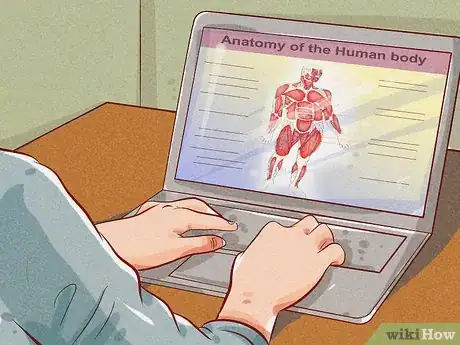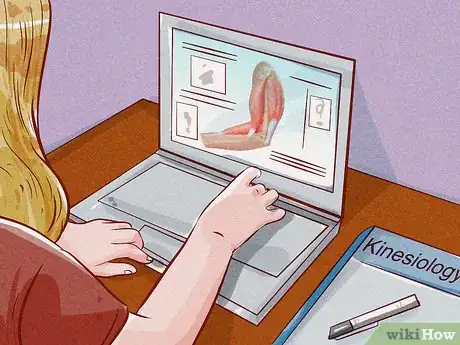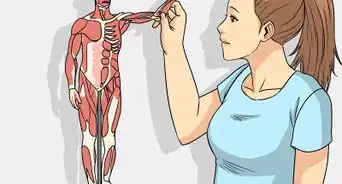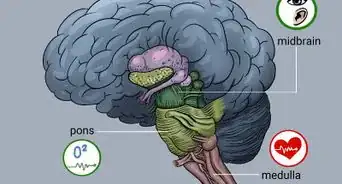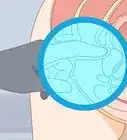This article was co-authored by wikiHow Staff. Our trained team of editors and researchers validate articles for accuracy and comprehensiveness. wikiHow's Content Management Team carefully monitors the work from our editorial staff to ensure that each article is backed by trusted research and meets our high quality standards.
There are 15 references cited in this article, which can be found at the bottom of the page.
This article has been viewed 13,807 times.
Learn more...
Kinesiology is a fascinating field of study for anyone interested in the way the human body moves. To begin learning the fundamentals of kinesiology, read textbooks and scholarly journals on the dynamics of movement, and use helpful study tools like flash cards and visual aids to cement your understanding. If you're interested in becoming a professional kinesiologist, you'll need to complete a formal education by enrolling in a kinesiology program at a reputable 4-year university or seeking independent certification through an Applied Kinesiology school.
Steps
Getting Acquainted with Key Concepts
-
1Familiarize yourself with the anatomy of the human body. Kinesiology and anatomy go hand-in-hand. Learn the names of the major muscle groups and bones in the original Greek and Latin languages. Once you've got those down, zoom in on the smaller muscles, tendons, ligaments and other parts.
- Labelled diagrams, detailed photographs and charts, and other resources can all be turned up with a quick internet search.
- It's necessary to first know the body's basic components before you can begin making sense of how they move.
-
2Learn the etymology of common roots words. Keep an eye out for prefixes and suffixes that you encounter frequently during the course of your reading and begin jotting them down. Make an effort to commit these to memory. That way, you'll know what they mean the next time you run into them.[1]
- The majority of the specialized terminology used in kinesiology come from the Greek and Latin languages, including the names of many bones, muscle groups, anatomical configurations, and motor patterns.[2]
- By picking up some basic etymology, you'll have an easier time understanding new terms and concepts.
Advertisement -
3Make flash cards. Write the name of an important body part, physiological process, or condition on the face of each card. On the opposite side, list the term's corresponding meaning or location. Work your way through the deck, trying to correctly identify each term. Flip the card over when you get stumped.[3]
- If you're following along with a textbook, create a set of flashcards for the main vocabulary terms featured in each chapter.
- Have a friend help you study by rapidly presenting the cards to you and prompting you to recite the meaning or location of each term.
-
4Use visual aids. Look over a variety of images, diagrams, charts, and videos that depict how the different parts of the body move. Pay particular attention to the action of the agonist and antagonist muscles that work against one another to produce simple and complex movements.[4]
- You should be able to find plenty of helpful resources in kinesiology textbooks and similar publications.
- As your knowledge grows, you can begin creating your own visual aids by sketching out representations of important concepts from memory.[5]
-
5Watch sports, dance, or other forms of recreational movement. Tuning in to a gymnastics competition or episode of Dancing With the Stars can be a fun and engaging way to study the visual component of kinesiology. When it comes to learning about the dynamics of movement, there's no substitute for seeing it in action—think of it as homework.[6]
- While you're watching, take note of things like which muscles are used to perform certain movements, how force is transferred, and what sorts of motor patterns outstanding athletes have in common.
- Try to analyze at least an hour or 2 of illustrative footage every week.
-
6Quiz yourself. Put together practice quizzes periodically to test the knowledge you've gained. Your quizzes can consist of multiple choice or fill-in-the-blank questions related to the material you've been studying most recently. You could even prompt yourself to write a short essay explaining a concept you have trouble articulating.[7]
- By selecting questions that highlight your weak points rather than what you already know, you stand to strengthen your understanding of important theories and ideas.
- Textbook publishers often make free practice tests available online.
Earning a Kinesiology Degree
-
1Receive your high school diploma. In order to kickstart a successful career as a kinesiologist, you'll first need to finish high school. Kinesiology is a highly technical field of study, one that requires a college degree in order to be practiced professionally.
- Work hard to make good grades while you're still in high school. The better your academic performance, the better your chances of being accepted to your college of choice later on.
- You can also go for your GED, although some colleges require that prospective students hold a high school diploma in order to be eligible for admission.[8]
-
2Sign up for related classes at a community college (optional). Many 2-year schools and vocational academies offer courses on anatomy and physiology. If you plan on attending community college before you make the jump to a larger university, enrolling in one or both of these courses can be a good way to get a headstart on your education.[9]
- You may even find introductory kinesiology courses listed on the curriculum at some community colleges.[10]
- By choosing your course load carefully, you'll already have a basic grasp of the way the human body moves by the time you enter a kinesiology program at a 4-year school.
-
3Apply for universities with kinesiology programs. Research colleges in your area to find out which ones offer degree programs in kinesiology or exercise science. These are up-and-coming and relatively popular courses of study, so you'll likely have a few different options to choose from.[11]
- If you live in the U.S., visit the website of the American Kinesiology Association to take a look at their list of accredited institutions with celebrated kinesiology programs.[12]
- Put together a list of the top 3-5 schools you want to attend. That way, you'll have a backup plan in the event that you don't hear back from your first couple of choices.
-
4Complete your 4-year degree program. In addition to the central kinesiology courses, you make also be expected to take courses like advanced anatomy, exercise physiology, biomechanics, and nutrition as part of your program. Together, these subjects will give you a more comprehensive understanding of the capabilities of the human body.[13]
- With a bachelor's degree, you can begin looking for employment as a physical education teacher, physical therapy or research assistant, or personal trainer.
Exploring Additional Education Options
-
1Consider moving on to graduate program. A bachelor's degree is the minimum academic requirement for most human health occupations. However, some positions may specify that applicants hold a Master's or Ph.D. Earning an advanced degree can significantly increase the number of employment opportunities open to you when you finish school.[14]
- Coveted kinesiology career paths like sports medicine and physical therapy almost always require a Master's degree or higher.
- Once you enter a graduate program, you'll have the freedom to begin exploring various specializations that align more directly with your particular goals and interests.
-
2Seek an Applied Kinesiology certification if you already have a career. Applied Kinesiology schools offer an alternative to university-based education. These schools usually teach the same core subjects, only in the form of expedited 100- or 300-hour hands-on programs. Upon graduating from kinesiology school, you'll be awarded a certification making you eligible to work as chiropractor, physical therapist, rehabilitation counselor, or similar professional.[15]
- If you have an extensive background as a chiropractor, yoga instructor, or therapy assistant, kinesiology school might be a more feasible option than going through a 4-year university.
- Applied kinesiology falls under the banner of alternative medicine, which means it isn't necessary to have previous experience in kinesiology, medicine, or exercise science in order to earn your certification.[16]
- Check out The Kinesiology Network for a list of Applied Kinesiology schools around the U.S.
-
3Continue your studies independently. Even if you don't decide to pursue formal schooling, you can expand your knowledge by reading textbooks, articles, and other publications on your own time. Devour as many titles you can on the science of kinesiology, along with related subjects like anatomy, physiology, exercise science, and even nutrition.[17]
- Annual or quarterly kinesiology journals, such as the International Journal of Kinesiology & Sports Science, can also make learning great resources.[18]
- A little independent study can serve as a useful primer on the kinds of concepts and terminology you'll encounter throughout your time in school.
References
- ↑ https://www.medicalsciencenavigator.com/10-tips-for-how-to-learn-anatomy-physiology/
- ↑ https://www.barnardhealth.us/qualitative-analysis/review-of-key-anatomical-concepts.html
- ↑ https://brentbrookbush.com/articles/q-a/how-do-i-memorize-kinesiology/
- ↑ https://brentbrookbush.com/articles/q-a/how-do-i-memorize-kinesiology/
- ↑ http://kahsso.club.yorku.ca/kahsso-peer-tutor-program/our-study-tips/
- ↑ http://theconversation.com/watching-sport-is-far-more-than-just-pure-dumb-entertainment-46952
- ↑ https://easy-anatomy.com/13-tips-for-studying-anatomy-more-effectively/
- ↑ http://education.seattlepi.com/colleges-look-high-school-diploma-vs-ged-1734.html
- ↑ https://www.dcccd.edu/cd/ce/cepgms/health/pages/anatomy-physiology.aspx
- ↑ https://www.glendale.edu/academics/academic-divisions/kinesiology-division
- ↑ https://learn.org/articles/Kinesiology_How_to_Become_a_Kinesiologist_in_5_Steps.html
- ↑ http://americankinesiology.org/SubPages/Pages/Kinesiology%20Institution%20Database
- ↑ http://kahsso.club.yorku.ca/kahsso-peer-tutor-program/our-study-tips/
- ↑ https://learn.org/articles/Kinesiology_How_to_Become_a_Kinesiologist_in_5_Steps.html
- ↑ https://www.naturalhealers.com/physical-therapy/applied-kinesiology/
- ↑ https://learn.org/articles/Applied_Kinesiology_Courses_Frequently_Asked_Questions.html
- ↑ http://guides.libraries.psu.edu/kines/recbooks
- ↑ http://www.journals.aiac.org.au/index.php/IJKSS
